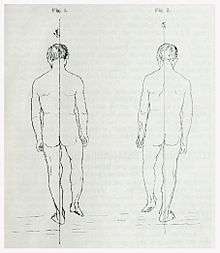Trendelenburg's sign

Trendelenburg's sign is found in people with weak or paralyzed abductor muscles of the hip, namely gluteus medius and gluteus minimus. It is named after the German surgeon Friedrich Trendelenburg.
The gluteus medius is very important during the stance phase of the gait cycle to maintain both hips at the same level. Moreover, one leg stance accounts for about 60% of the gait cycle. Furthermore, during the stance phase of the gait cycle, there is approximately three times the body weight transmitted to the hip joint. The hip abductors' action accounts for two thirds of that body weight. The Trendelenburg sign is said to be positive if, when standing on one leg, the pelvis drops on the side opposite to the stance leg to reduce the load by decreasing the lever arm. By reducing the lever arm, this decreases the work load on the hip abductors. The muscle weakness is present on the side of the stance leg. A Trendelenburg sign can occur when there is presence of a muscular dysfunction (weakness of the gluteus medius or minimus) or when someone is experiencing pain. The body is not able to maintain the center of gravity on the side of the stance leg. Normally, the body shifts the weight to the stance leg, allowing the shift of the center of gravity and consequently stabilizing or balancing the body. However, in this scenario, when the patient/person lifts the opposing leg, the shift is not created and the patient/person cannot maintain balance leading to instability.